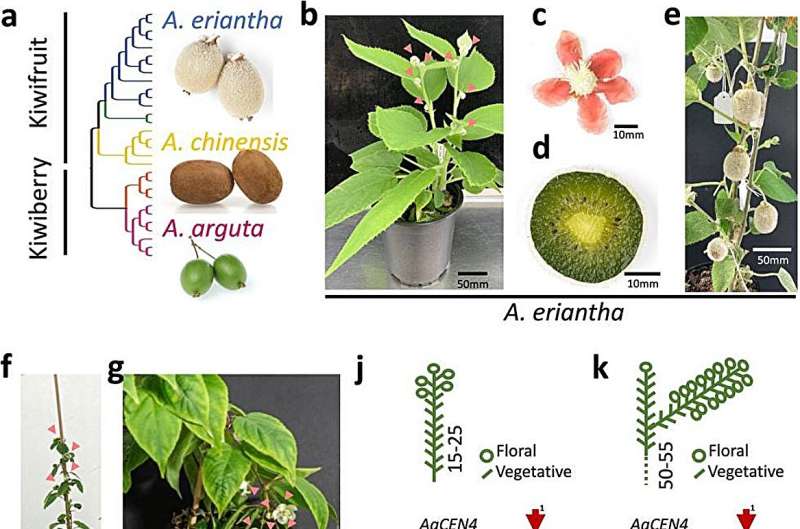This article has been reviewed according to Science X's editorial process and policies. Editors have highlighted the following attributes while ensuring the content's credibility:
fact-checked
peer-reviewed publication
trusted source
proofread
Revolutionizing kiwifruit cultivation: Cutting-edge breeding strategies for Actinidia

While major advances have been made through speed breeding and other technologies, woody perennial fruit tree species have lagged behind. Among these is the kiwifruit (Actinidia chinensis), a crucial fresh fruit crop, which has limited genetic diversity and faces obstacles like long generation times, large plant size, and reliance on chilling.
Notably, the Actinidia genus, with over 50 edible fruit species, presents an untapped potential for future cultivation. However, the primary hindrance in domesticating these fruits is their extended juvenility.
Recent studies have shown promising results using CRISPR-Cas9 gene editing on kiwifruit's CENTRORADIALIS genes (CEN and/or CEN4), leading to early maturity without harmful effects, albeit with some limitations. The challenge now is to expand and refine these genetic interventions for wider fruit crop improvement.
In February 2023, Horticulture Research published a perspective entitled "Strategies for fast breeding and improvement of Actinidia species."
Due to the fact that kiwifruit may take up to five years to bloom for the first time in a greenhouse, it will greatly extend the breeding time of kiwifruit.
The authors utilized gene editing mediated by RISPR Cas9 to edit the alleles of CEN and successfully obtained the edited plants of A. eriantha and A. arguta, which showed significant dwarfing and very fast flowering.
In order to produce a dynamic early maturing kiwifruit plant that can transfer early flowering traits to heterozygous offspring they further utilized constitutive expression from the 35S promoter of a translational fusion of the AcFT1 gene integrated with six copies of the hemagglutinin (HA) tag sequence.
Initial results showed a milder early flowering phenotype with this chimeric FT protein. Upon transformation of this construct into kiwifruit, the outcome was 16 viable transgenic kiwifruit plants, with some exhibiting an early terminal flowering pattern. This pattern was observed as early as three weeks post-germination and continued up to 14 weeks.
Similar results were noticed when the same construct was introduced into A. arguta. In contrast, those without the HA tag didn't produce viable in vitro flower and fruit development.
For accelerated breeding in Actinidia, the observed reduced juvenility and continuous flowering patterns have opened doors to various strategies. By editing CEN4 and CEN genes, early flowering can be embedded into a variety of Actinidia genetic backgrounds. Hence, the introduction of a high value trait (HVT), such as fruit quality or disease resistance, is possible.
The following step would involve the removal of the transgene through breeding. By employing a rapid-cycle breeding approach using the early flowering lines, researchers can quickly derive improved, non-transgenic offspring possessing the desired trait. Further enhancements include inducing hermaphroditism using specific genes, facilitating easier breeding.
To address ploidy variations, researchers can apply in vitro chromosome doubling techniques, which enables fertile interspecies crossings and the development of seedless varieties.
In conclusion, the combined strategies of CRISPR-Cas9 editing of CEN genes, expression of tagged FT, manipulation of ploidy, and hermaphroditism induction present promising advancements in Actinidia breeding. These advancements not only enhance domestication but also ensure a consistent supply of high-quality fruits, thereby contributing to global food security amid shifting climatic conditions.
More information: Dinum Herath et al, Strategies for fast breeding and improvement of Actinidiaspecies, Horticulture Research (2023). DOI: 10.1093/hr/uhad016
Journal information: Horticulture Research
Provided by NanJing Agricultural University




















